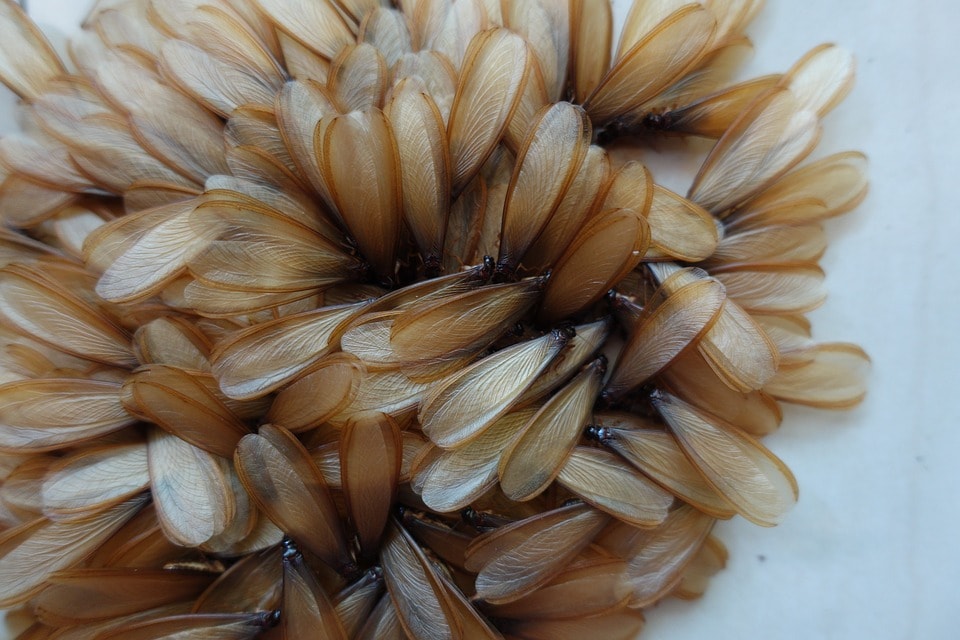Difference Between Flying Ants and Termites
Insects can be frightening, but flying insects are next level scary. Both ants and termites can develop wings, and immediately become more of a problem.
It’s important to know the difference between flying ants and flying termites as each poses a different threat, and require different treatments.
Both flying ants and flying termites travel in swarms searching for nests and to mate. Due to this habit, and their similarities in appearance, it’s very easy to confuse one with the other.
This article will shed some light on the basic differences between flying ants vs flying termites. At first glance, they’re quite difficult to tell apart because of their closely linked structures.
Difference in Physical Appearance
Flying termites
- The body is usually black or dark brown in color.
- They have wide bodies without a pinched waist.
- Antennae are straight.
- They possess four wings of equal length, two crystal clear wings on the front, and similar wings at the back
Flying ants
- Body colors vary from red to brown to black.
- Their body shape is irregular with a pinched waist.
- The antennae are elbowed.
- They come with two pairs of wings which are different in size.
- Their wings bear a slight tint of brown giving them a shiny appearance.

Flying ant by Joseph Berger, Bugwood.org
Difference in Behavior
You’ll find flying termites mostly inhabit decaying trees because it is easier for them to feed on the wood. They can also be found in the wood debris, wooden structures, wooden floors, furniture, lumber, and stumps.
Flying ants also inhabit wooden structures, but the major difference is that termites cause severe structural damage to the wooden structures. While ants do not feed on wood, so they don’t pose any real threat or cause serious damage. They merely just an annoyance.
—————————
The only behavioral similarity between flying ants and flying termites is their caste systems, and they both live in large colonies.
Control Exterminating Company
—————————
Difference in Diet
These two insects have altogether different eating habits. Flying ants are generally known to be omnivorous in nature. They usually will feed only on small insects, nectar, seeds, and food debris they find in and around your house.
However, flying termites get their nourishment from cellulose which is nutrient-rich plant material. Cellulose is found in abundance in plants and trees. Even products containing cellulose such as wood, paper, and cotton serve as a favorite diet for termites.

Flying termites
Difference in Life Cycle
The life cycle of termites passes through only three stages
- Egg
- Nymph
- Adult
For ants, their life cycle passes through four stages:
- Egg
- Larva
- Pupa
- Adult
When it comes to their lifespan, there is also another difference. A termite queen can live for decades, but the lifespan of adult termites is short as they live for just a couple of years.
Meanwhile, the lifespan of worker ants is very short, and they live for a couple of months. Male ants live only to mate, and they die shortly afterward. Only the queen ant has a longer lifespan, and it is able to live for several years.
Despite the differences in their life cycles, both flying ants and flying termites have similar reproductive cycles. Spring happens to be the swarming season when swarms of both ants and termites leave their respective colonies for mating. They also establish new colonies elsewhere at this time.
A major difference though is that male ants die after mating, while male termites, together with their female partners, take care of the expansion of their newly established colonies.
—————————
Both flying ants and flying termites lose their wings after they finish mating.
Control Exterminating Company
—————————
Flying Ants vs Flying Termites Infographic
Here is an easy to follow infographic to help you distinguish the difference between flying ants and flying termites should a swarm of either of them infest your home:

Flying Ants vs Flying Termites Infographic (by Control Exterminating Company)
It is easy to confuse flying ants with flying termites and vice versa. However, ignoring swarmers thinking they are only harmless ants can be disastrous, if they turn out to be termites instead.
So, the next time you see a flying swarm of insects in your house, observe them closely. Once you have identified them correctly, make sure you purchase the correct ant killer or termite killer product. If you have a massive ant infestation, don’t hesitate to call Control Exterminating. We’ll eradicate your ant problem thoroughly.
Related Articles:
[catlist name=”Ants”]

